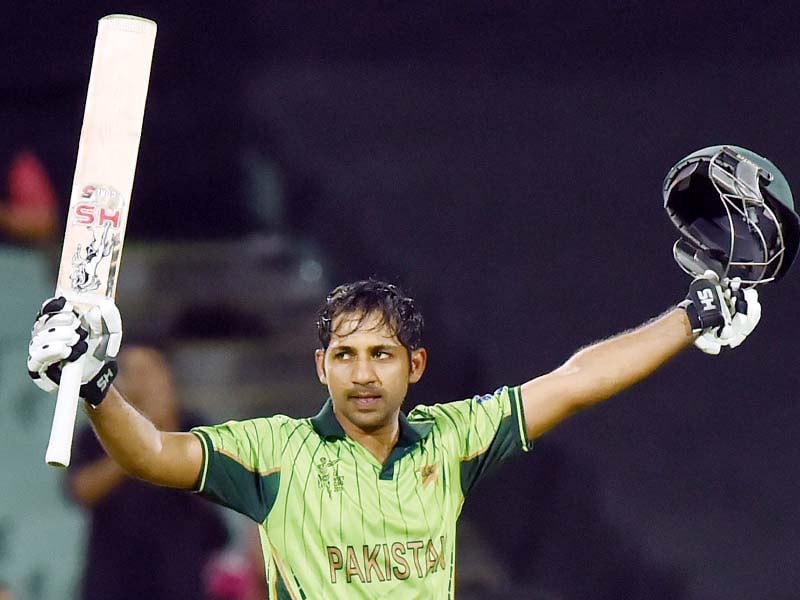
By losing their two opening matches, Pakistan made heavy work of qualifying from perhaps the easier of the two groups. But despite the two defeats and some closer-than-comfort calls, no one has troubled Pakistan as much as they have troubled themselves.
The team was already in hot water when Junaid Khan was ruled out and Saeed Ajmal could not make it to the mega event due to suspension.
Then Muhammad Hafeez’s injury made it worse, with the handling of the situation — as Nasir Jamshed was called as a replacement despite Hafeez scheduled to getting fit in two weeks — compounding matters.
When the first match of the World Cup finally arrived, all planning came crashing down against India.
Pakistan decided to snub two known openers in Jamshed and Sarfraz Ahmed, and Younus Khan was asked to open while Umar Akmal stood in as the wicketkeeper.
Both decisions backfired as Umar dropped a crucial catch of Virat Kohli, who went on to score a century, while Younus was found wanting against the new ball and Pakistan failed to end their jinx against India.
However, they refused to learn from their mistakes as they kept Sarfraz out, while Nasir was given a run in against the West Indies. Again, the fielding was woefully poor and an astounding six catches were dropped, with Umar and Shahid Afridi dropping a couple each.
The team paid for the errors as West Indies scored over 300 and Pakistan never got going after suffering the worst ever start to an ODI match — losing four wickets for just one run.
The men in green found themselves at the bottom of their group and were written off by many. In typical fashion, that is when the resurgence started.
After yet another poor display, the batsmen were bailed out by Wahab Riaz’s 54, which helped Pakistan post a fighting — albeit still decidedly under-par — total against Zimbabwe.
Wahab, along with Muhammad Irfan, then put the African side to the sword with some aggressive bowling as both claimed four wickets apiece to give Pakistan their first win.
Misbahul Haq’s men strolled through against the amateurs of UAE to register their second win and gain some much needed momentum.
However, Pakistan were still without a win against a tough opposition and that’s when South Africa came around. Sarfraz Ahmed was finally brought into the side instead of the out-of-form Jamshed and made a run-a-ball 49 to give Pakistan some impetus at the top.
A typical batting collapse meant Pakistan were reduced to 222 all out, defending 232 in 47 overs in a revised target.
The pace quarter of Wahab, Irfan, Rahat Ali and Sohail Khan really came into their own as Misbah backed their aggression with some uncharacteristically attacking field placements and bowling changes. It was enough to see Pakistan over the line as all our pacers were among the wickets and Sarfraz claimed a record-equalling six catches behind the stumps.
Sarfraz once again was pivotal as his century against Ireland ensured that Pakistan suffered no hiccups in the crunch match against Ireland, after Wahab and Sohail had brought the Irish first innings to a grinding halt with some impressive death bowling.
With a pace attack as good as any in the tournament, Pakistan’s batsmen need to play their part if the side are to have any hope of winning the tournament. The four seamers must also find support in Shahid Afridi who, despite not being among the wickets, has impressed.
English pride crushed; India, Australia and NZ impress

England, part of the much-hyped Big Three of cricket, had a build-up to the World Cup as damaging as Pakistan’s.
Eoin Morgan was brought in to replace Alistair Cook at the eleventh hour and the Irishman, perhaps the most out of form batsman in world cricket, was able to rally neither himself nor his troops. To add to that, James Anderson, Stuart Broad and Steven Finn, all looked toothless in conditions where other swing bowlers thrived.
As a result, the inventors of cricket, who have only one World Twenty20 title to their credit in what is more than a century-long history, have been knocked out.
While the other two members of the Big Three — India and Australia — have impressed in the tournament, with only one loss in 12 matches between them when Australia were downed in a nail-biter by co-hosts New Zealand, England were only able to defeat Associates Scotland and Afghanistan.
The only team who look like they could challenge India and Australia — who will face off in the semi-finals if they win their respective quarter-finals — are New Zealand, who also finished with a perfect record with six wins in six.
Bangladesh and Associates make their mark

England’s exit has been an unpleasant shock but a more pleasant one for world cricket was the performance of unheralded minnows.
Bangladesh qualified for the quarter-finals at the expense of England and the Associates — Ireland, Afghanistan, Scotland and UAE — all held their own against their more illustrious opponents.
When Bangladesh and England met to decide which of the two side will go through, it was the Asian side that held its nerve as Mahmudullah scored Bangladesh’s first ever World Cup century and Rubel Hussain picked up four wickets.
Mahmudullah then followed it with yet another century against favourites New Zealand.
Bangladesh gave a real hard time to Kiwis as well but the co-hosts eventually came out on top.
Ireland’s 2007 shock win over Pakistan has just not been a one-off and they have constantly improved.
William Porterfield’s charges left their impression on the biggest stage with their batting ability but were let down by their bowling — probably the worst of all teams.
Afghanistan registered their maiden win against Scotland and their fast-bowling was a treat to watch as the likes of Shahpoor Zadran, Hamid Hassan and Dawlat Zadran brought a kind of flair and aggression not normally associated with the Associates.
As for UAE, their proudest moment would have been when Shaiman Anwar was top of the run-scorers chart ahead of Kumar Sangakkara, Chris Gayle and Hashim Amla.
Anwar’s approach was different from the rest of the team’s batsman and he has certainly become a cricketing legend for his country, while his teammate Amjad Javed also made a name for himself with his all-round display.
The sides have certainly given food for thought to the ICC — who were planning to cut down the number of teams to 10 for the 2019 World.
The likes of Anwar, Scotland’s Joshua Davey and Kyle Coetzer, and Afghanistan Shahpoor and Samiullah Shinwari have bowed out as heroes.
Zimbabwe are another side outside the top-eight that impressed but were unfortunate despite coming up with impressive displays, especially against Pakistan and South Africa. However, in the end, they were knocked out by Ireland in yet another close encounter.
Proteas caught between choking and chokeslamming

At times, South Africa have been ruthless, becoming the first team to register scores of 400 in back-to-back matches when they did so against the West Indies and Ireland — the phenomenal Ab de Villiers being pivotal to both scores.
AB has been breaking records for fun as he scored World Cup’s second-fastest century in 52 balls and scored ODI’s fastest 150 off 64 deliveries against the Windies as skipper Jason Holder ended up conceding 104 in his 10.
But whenever the situation has demanded South Africa to excel, the Proteas have only given strength to the legend of ‘chokers’ as they lost to both Pakistan and India — the only two sides in their group that were capable of beating them.
Batsmen stamp their authority over the game

As many as 35 centuries have been scored in the group stages, with Sangakkara scoring four consecutive hundreds to become the first batsman in ODIs internationals to do so.
Sarfraz’s century in the final match of the stage meant that Afghanistan were the only side in the tournament who did not score a century — despite coming agonisingly close when Shenwari made 96 against Scotland.
Sri Lanka head the list with eight centuries, while South Africa have five, India four and the West Indies and Australia, three each.
Bangladesh have two (both by Mahmudullah), so do eliminated England, Ireland and Zimbabwe (both by Brendon Taylor). Those who have scored a century each include New Zealand, Pakistan, UAE and Scotland.
The dominance of batsmen was best summed up by Chris Gayle’s knock of 215 as he shared a record 372-run stand with Marlon Samuels against a clueless Zimbabwean bowling attack.
The bowling displays
But the batsmen have not had everything their own way. New Zealand seamer Tim Southee started things off for the bowlers with his seven-wicket haul when his late swinging deliveries proved too good for England.
West Indies Jerome Taylor followed it up a day later as his three-wicket burst left Pakistan reeling on 1-4.
The best match was the low-scoring thriller between the two co-hosts, Australia and New Zealand, where fast-bowlers really made their mark as 19 wickets fell for 303 runs — 16 of which were claimed by the pacers.
Trent Boult’s five-wicket haul was followed up by Mitchell Starc, who has taken over from Mitchell Johnson as Australia’s spearhead in the tournament. Starc dragged his team back into the game with six wickets, reducing New Zealand from 78-2 to 146-9. However, Kane Williamson — watching Starc’s carnage helplessly from the other end — finished it off with a six of Pat Cummins.
Scotland’s Joshua Davey deserves a special mention as the Broad lookalike led the bowling charts for a while and finished witeh 15 wickets to his name. Pakistani pacers Wahab Riaz and Sohail Khan have been the standout performers at the death, save for the match against the West Indies when both were cut into pieces by Andre Russell.
Published in The Express Tribune, March 17th, 2015.
Like Sports on Facebook, follow @ETribuneSports on Twitter to stay informed and join in the conversation.


1727778647-0/diddy-(16)1727778647-0-165x106.webp)

1732014631-0/BeFunky-collage-(71)1732014631-0-165x106.webp)
1732000633-0/Express-Tribune-(3)1732000633-0-270x192.webp)











COMMENTS
Comments are moderated and generally will be posted if they are on-topic and not abusive.
For more information, please see our Comments FAQ